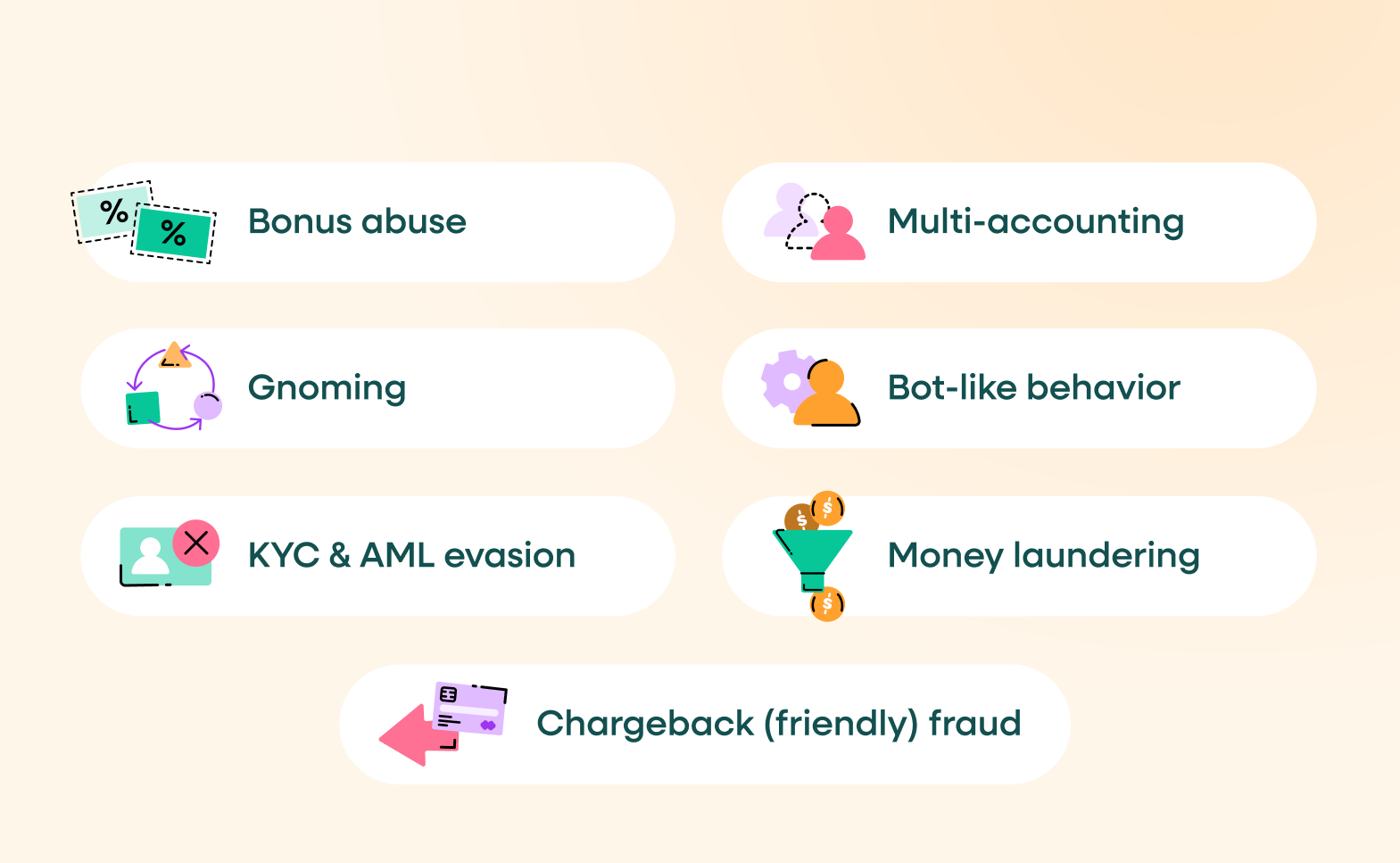Online gambling operators face rising pressure to meet AML and KYC requirements while protecting players and driving growth. Fraud detection is still quite manual and time-consuming in many cases, making it difficult to act quickly. Operators need to spot risky behavior in real time without disrupting loyal players.
In 2024 alone, gambling and betting sites lost more than $1B to fraud, with rates rising 64% since 2022, evidence that the problem is escalating fast (GamblingIQ).
The challenge with identifying fraudulent gambling behavior
Most monitoring systems use static rules to flag potential issues. These systems often trigger too many false positives, making it harder for teams to focus on real problems. Delays in fraud detection don’t just mean missed opportunities; they create revenue loss and distort key performance metrics.
When KPIs like average deposit size or conversion rate suddenly spike, it may signal fraud rather than success. Leaders across product, operations, and the C-suite need confidence that growth is real, not risk in disguise.
Real-time behavioral fraud detection helps gambling operators protect legitimate players and stay compliant.
Video transcription
Common fraudulent behaviors in iGaming
Common fraudulent behaviors might look like:
Bonus abuse: Creating multiple accounts or using fake identities to repeatedly claim welcome offers or referral bonuses.
Multi-accounting: Operating several accounts to bypass limits, avoid detection, or exploit promotions.
Gnoming: Coordinated use of multiple accounts by different users to manipulate outcomes or distribute winnings.
Bot-like behavior: Using automated scripts or tools to place bets, redeem bonuses, or simulate real user activity.
Chargeback fraud (friendly fraud): Depositing funds, placing bets, and then disputing charges to reclaim money.
Money laundering: Moving illicit funds through low-risk bets and rapid transactions across multiple accounts.
KYC and AML evasion: Bypassing identity checks with false documents, synthetic identities, or account cycling.
These signs can appear subtle at first—frequent failed verification attempts, rapid switching between pages, abandoned deposits or bonuses, and other indicators that something isn't quite right.

On their own, these actions may not raise concern. But together, they can point to a larger issue.
Bonus abuse
Bonus abuse is one of the most prevalent types of iGaming fraud. Players may use fake identities, VPNs, or TOR browsers to create multiple accounts and repeatedly claim welcome offers. In some cases known as affiliate fraud, these fake accounts are tied to referral scams to game bonus payouts even further.
Watch for: Repeated use of promo codes, similar device/browser fingerprints across accounts, or sign-ups with slightly varied email addresses.
Multi-accounting
Players may create multiple accounts to bypass betting limits, evade self-exclusion policies, or avoid detection. This undermines responsible gambling protocols and pollutes your customer data.
Watch for: Overlapping IPs, shared payment methods, device reuse,rapid login-logout cycles, or sign-ups using temporary email addresses—a tactic QA teams sometimes adopt for quick testing.
Gnoming
A form of coordinated multi-accounting, gnoming involves multiple users colluding to manipulate betting outcomes or share winnings. It’s especially hard to detect without behavioral context.
Watch for: Synchronized activity between accounts, shared network indicators, or patterns tied to specific promotions.
Bot-like behavior
Fraudsters sometimes use automated scripts or tools to place bets, redeem bonuses, or mimic user behavior at scale. These bots can overwhelm systems with low-value activity or exploit betting mechanics—often hiding in plain sight without detailed behavioral data.
Watch for: Unnaturally fast movements, repetitive click paths, or sessions with no pause or hesitation—signals that become clearer when you can see the full user journey.
Chargeback fraud (friendly fraud)
Some users deposit funds, place bets, and then file a dispute with their bank to reclaim the money—leaving the operator to absorb the loss. This tactic, known as chargeback fraud or friendly fraud, is especially tricky because it comes from seemingly legitimate accounts.
Watch for: Disputed charges after recent wins, repeated chargeback behavior, or fast deposit-to-withdrawal activity.
Money laundering
Fraudsters use gambling platforms to wash illicit funds—often through small, low-margin bets or rapid transactions across multiple accounts. Known as layering, this method can go unnoticed without deep behavioral and real-time transactional insight.
Watch for: High-volume, low-risk bets, unusual deposit and withdrawal patterns, or account connections across regions.
KYC and AML evasion
To avoid identity checks or AML screening, some players submit fraudulent documents or cycle through new accounts. Failure to catch this behavior creates legal exposure.
Fullstory gives teams the building blocks to configure a dashboard that surfaces these markers in real-time, layering behavioral clues over your backend data so you can gauge risk instantly. Analysts can jump straight from an alert to the exact session replay to validate intent and prioritize the next move.
Watch for: Repeated document submissions, incomplete KYC steps, mismatched user and payment info, or unusual drop-off points in the verification flow.
Each of these behaviors is serious on its own. But when they start to layer, they can signal something bigger. The key is being able to connect the dots early, with enough behavioral context to act fast.
While fraud losses continue to climb, technology is making a difference. Up to 50% of operators are now successfully blocking fraudulent activity with advanced solutions. Still, many remain exposed, and traditional approaches alone aren’t enough.
Why operators trust Fullstory for iGaming security
Unlike traditional flagging systems, Fullstory helps target the right players instead of casting a wide net.
Teams can move beyond static rules by pairing behavioral data with existing fraud tools through Anywhere: Activation. Session replay lets analysts confirm intent and triage alerts, while AI-driven anomaly detection and behavioral biometrics reveal patterns traditional systems miss. Real-time monitoring connects fraud signals with digital behavior for faster, more accurate action.
Built on Google Cloud’s AI-driven infrastructure, Fullstory efficiently processes large volumes of behavioral and transactional data, helping operators act faster and stay compliant with responsible gambling regulations.
Video transcription
The impact: Lower fraud losses, stronger AML compliance
By moving from lagging, blanket flagging systems to a behavioral data approach, operators can satisfy AML and KYC mandates in real time, spotting bonus abuse, chargebacks, and money-laundering attempts before they breach regulatory thresholds.






